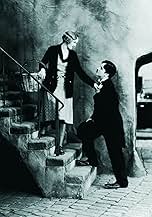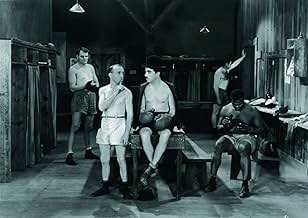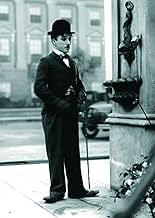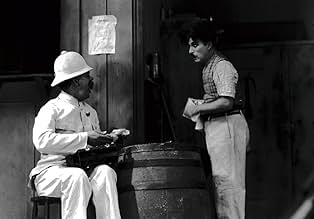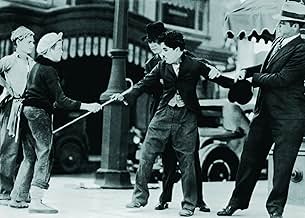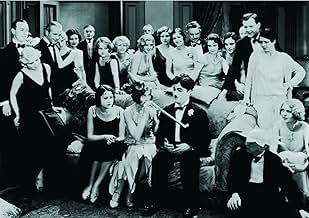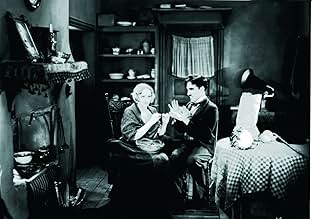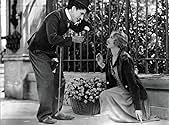Con la ayuda de un hombre adinerado, borracho e imprevisible, un ingenuo vagabundo que se ha enamorado de una florista ciega intenta conseguir dinero para poder proporcionarle ayuda médica.Con la ayuda de un hombre adinerado, borracho e imprevisible, un ingenuo vagabundo que se ha enamorado de una florista ciega intenta conseguir dinero para poder proporcionarle ayuda médica.Con la ayuda de un hombre adinerado, borracho e imprevisible, un ingenuo vagabundo que se ha enamorado de una florista ciega intenta conseguir dinero para poder proporcionarle ayuda médica.
- Dirección
- Guionistas
- Elenco
- Premios
- 6 premios ganados en total
Charles Chaplin
- A Tramp
- (as Charlie Chaplin)
Al Ernest Garcia
- The Millionaire's Butler
- (as Allan Garcia)
Johnny Aber
- Newsboy
- (sin créditos)
Jack Alexander
- Boxing Match Spectator
- (sin créditos)
T.S. Alexander
- Doctor
- (sin créditos)
Victor Alexander
- Superstitious Boxer
- (sin créditos)
Albert Austin
- Street Sweeper
- (sin créditos)
- …
Harry Ayers
- Cop
- (sin créditos)
Eddie Baker
- Boxing Fight Referee
- (sin créditos)
Henry Bergman
- Mayor
- (sin créditos)
- …
Edward Biby
- Nightclub Patron
- (sin créditos)
Betty Blair
- Woman at Center of Table in Restaurant
- (sin créditos)
Buster Brodie
- Bald Party Guest
- (sin créditos)
Jeanne Carpenter
- Diner in Restaurant
- (sin créditos)
- Dirección
- Guionistas
- Todo el elenco y el equipo
- Producción, taquilla y más en IMDbPro
Resumen
Reviewers say 'City Lights' is celebrated for its blend of comedy and pathos, showcasing Charlie Chaplin's iconic Tramp character in a poignant love story with a blind flower girl. The film is praised for its masterful physical comedy, expressive acting, and memorable scenes, particularly the boxing match and the emotional finale. Chaplin's direction, composition of the score, and the film's historical significance are frequently highlighted. However, some reviewers note that the silent format and slow pacing may challenge modern audiences. The themes of love, selflessness, and social commentary resonate deeply, making 'City Lights' a timeless classic.
Opiniones destacadas
As always the little tramp is fleeing the long arm of the law when he is mistaken for a wealthy man by a blind girl selling flowers by the roadside. While he longs to help her the tramp knows he cannot. However when he is at his lowest he stumbles upon a drunken man who he helps out who may be able to help him in turn if the two of them can sober up long enough.
In response to seeing some modern trash posing as "comedies" recently (Little Man, Norbit, Pluto Nash I'm looking at you) I decided to check out some comedies that have stood the test of time a few Chaplin films being among them. City Lights is one of those film that you will think you have seen even when you have not. I knew I had never actually seen it but the wonderful opening scene on the statue and the scenario of the blind girl by the side of the road were very familiar to me and I was right into it from the start. As was often the case, this film has a thin narrative but one that allows for several scenarios for Chaplin to work his magic. And so he does with some classic sequences across the whole film.
The statue scene is memorable for how he makes so much out of so little but the brilliant choreography of the boxing match had me rolling with laughter as it moved so beautifully and imaginatively around the ring. Chaplin is a master and this is just one of many films that shows it as he creates a great little clown that we care about but can also laugh at. His support do no more than that support him but yet they are also roundly good. Cherrill provides attractive heart despite her simple character, while Myers, Garcia, Mann and a few others do good physical work alongside Chaplin.
City Lights is a really great film that is all the more impressive for still feeling fresh and funny more than seventy years after it was made. The simple narrative is the frame but it is the wonderful and frequent set-pieces that tickle and also stick in the mind. So tonight you might be looking at your film queue with lots of modern comedies but it is worth bumping this classic to the top of the list instead.
In response to seeing some modern trash posing as "comedies" recently (Little Man, Norbit, Pluto Nash I'm looking at you) I decided to check out some comedies that have stood the test of time a few Chaplin films being among them. City Lights is one of those film that you will think you have seen even when you have not. I knew I had never actually seen it but the wonderful opening scene on the statue and the scenario of the blind girl by the side of the road were very familiar to me and I was right into it from the start. As was often the case, this film has a thin narrative but one that allows for several scenarios for Chaplin to work his magic. And so he does with some classic sequences across the whole film.
The statue scene is memorable for how he makes so much out of so little but the brilliant choreography of the boxing match had me rolling with laughter as it moved so beautifully and imaginatively around the ring. Chaplin is a master and this is just one of many films that shows it as he creates a great little clown that we care about but can also laugh at. His support do no more than that support him but yet they are also roundly good. Cherrill provides attractive heart despite her simple character, while Myers, Garcia, Mann and a few others do good physical work alongside Chaplin.
City Lights is a really great film that is all the more impressive for still feeling fresh and funny more than seventy years after it was made. The simple narrative is the frame but it is the wonderful and frequent set-pieces that tickle and also stick in the mind. So tonight you might be looking at your film queue with lots of modern comedies but it is worth bumping this classic to the top of the list instead.
Film has become a medium that is strongly influenced by nostalgia. Old films have become journeys to the past; ways to visit times and people that no longer are. Since film is an art that is based on the innovation of previous works, it has an element of nostalgia in its foundation. We look on the old to find what elements should make up the new. In City Lights, and other silent works of film, a passion emerges that is uniquely honest and sincere. While watching the film, I was impressed that Chaplin really did love the story, the sets, the crew; the whole project. While this may not have been the complete reality, it felt that way, and thus made the film more enjoyable. In silent films the audience is forced to be completely reliable on the visual elements of the film; there are no elaborate sound effects or dialogue to provoke an emotional response.
Since film is at its very core a visual medium, I find silent films to be the basic form of the medium. I don't use the word basic here in a demeaning sense, but I compare the beauty of silent films to the beauty of early European art, before the concept of perspective was developed in the Renaissance. Many books and tomes featured people as tall as the castles they stood in; these works of art were not technologically advanced, but they were, and are, beautiful. The same example is found when comparing early darreographs of wild animals to contemporary photographs found in National Geographic. There is a warmth found in City Lights, and other Chaplin films (The Kid, Modern Times) that would be lost in the sea of cinematic technology that floods films today. Maybe it's just that with simplicity comes honesty, and honesty is perhaps the most powerful emotion that can cross through the screen and be felt by the viewer.
Since film is at its very core a visual medium, I find silent films to be the basic form of the medium. I don't use the word basic here in a demeaning sense, but I compare the beauty of silent films to the beauty of early European art, before the concept of perspective was developed in the Renaissance. Many books and tomes featured people as tall as the castles they stood in; these works of art were not technologically advanced, but they were, and are, beautiful. The same example is found when comparing early darreographs of wild animals to contemporary photographs found in National Geographic. There is a warmth found in City Lights, and other Chaplin films (The Kid, Modern Times) that would be lost in the sea of cinematic technology that floods films today. Maybe it's just that with simplicity comes honesty, and honesty is perhaps the most powerful emotion that can cross through the screen and be felt by the viewer.
City Lights is simply put one of the best movies out there. Every scene is classic and had a huge impact on the history of film-making. Chaplin's last 'silent' film tells the story of a poor little man the tramp played by Chaplin who falls in love with a blind flower girl. He becomes friends with a wealthy man who constantly tries to commit suicide. The man only recognizes the tramp character when he is drunk. To impress the flower girl the tramp uses the man's wealth to make her fall in love with him. The only problem is that when the man is sober he doesn't recognize the tramp anymore. On top of this the flower girl has to pay 22 dollars of rent or she will be thrown out of her apartment. Now the tramp desperately seeks for jobs in the city to help his love. Out of this simple plot great comedy and heart breaking moments come forth.
The outcome of the movie is to almost all people known. It is regarded as one of the best endings ever taped on film. The movie itself still is masterpiece more than 70 years after it's release. I personally rate this as Chaplin's second best I have seen so far. My favorite remains The Gold Rush. Still this movie gets 5/5 stars from me.
The outcome of the movie is to almost all people known. It is regarded as one of the best endings ever taped on film. The movie itself still is masterpiece more than 70 years after it's release. I personally rate this as Chaplin's second best I have seen so far. My favorite remains The Gold Rush. Still this movie gets 5/5 stars from me.
Charlie Chaplin's "City Lights" contains a blend of humor and humanity that make it memorable for everyone who watches it. Although made very much in the old-fashioned silent film tradition, much of it is timeless, too.
After a few minutes of slapstick at the beginning, Charlie's "little tramp" character makes two acquaintances. He meets a blind girl selling flowers, who mistakes him for a rich man, and the two become very fond of each other. Then he meets a real millionaire, who is drunk, depressed, and about to commit suicide. In a comic scene, the tramp persuades the millionaire not to go through with it, making himself a devoted friend.
The tramp soon learns that there is an operation that could give the girl her sight, and tries to think of some way he could help. His scenes with the girl and her grandmother are moving, while his determination to help lead him into some comic escapades - his attempt to win money in a boxing match being particularly funny, and one of Chaplin's best comic pieces. Meanwhile, when his millionaire friend is drunk, he dotes on the tramp, but when sober he forgets who the tramp is, leading to more amusing scenes and occasional trouble for Charlie.
All of the comedy leads up to a finale that is one of the best-remembered scenes in any film. "City Lights" shows the power of the camera in the hands of a master, who without words can move his audience or make them laugh. Anyone who appreciates good cinema should see it at least once.
After a few minutes of slapstick at the beginning, Charlie's "little tramp" character makes two acquaintances. He meets a blind girl selling flowers, who mistakes him for a rich man, and the two become very fond of each other. Then he meets a real millionaire, who is drunk, depressed, and about to commit suicide. In a comic scene, the tramp persuades the millionaire not to go through with it, making himself a devoted friend.
The tramp soon learns that there is an operation that could give the girl her sight, and tries to think of some way he could help. His scenes with the girl and her grandmother are moving, while his determination to help lead him into some comic escapades - his attempt to win money in a boxing match being particularly funny, and one of Chaplin's best comic pieces. Meanwhile, when his millionaire friend is drunk, he dotes on the tramp, but when sober he forgets who the tramp is, leading to more amusing scenes and occasional trouble for Charlie.
All of the comedy leads up to a finale that is one of the best-remembered scenes in any film. "City Lights" shows the power of the camera in the hands of a master, who without words can move his audience or make them laugh. Anyone who appreciates good cinema should see it at least once.
If there is one Charlie Chaplin film to recommend, as others have pointed to in the past, City Lights is the one. Though Chaplin played his Tramp character superbly in other movies, like Modern Times and The Gold Rush, City Lights displays the Tramp at his funniest, his bravest, his most romantic, and his most sympathetic. It's tough for filmmakers in recent days to bring the audience so close emotionally with the characters, but it's pulled off.
The film centers on three characters- the Tramp, the quintessential, funny homeless man who blends into the crowd, but gets caught in predicaments. He helps a drunken businessman (Myers, a fine performance in his own right) from suicide, and becomes his on and off again friend (that is, when it suits him and doesn't notice his 'friend's' state). The other person in the Tramp's life is the Blind Flower Girl (Virginia Cherrill, one of the most absorbing, beautiful, and key female performances in silent film), who are quite fond of each other despite the lack of total perception. The emotional centerpiece comes in obtaining rent and eye surgery money, which leads to a (how else can I put it) magical boxing match where it's basically a 180 from the brutality and viscerality of a match in say Raging Bull.
Though there is no dialog, the film achieves a timelessness- it's essentially a tale of two loners who find each other, lose each other, and find each other again (the last scene, widely discussed by critics for decades, is moving if not tear-inducing). And it's never, ever boring- once you get along with the Tramp, you find the little things about him, the reaction shots, the little things he does after the usual big gag (look to the ballroom scene for examples of this, or when he gets a bottle of wine poured down his pants without the other guy noticing). Truth be told, if this film makes you indifferent, never watch Chaplin again. But if you give yourself to the film, you may find it's one of the most charming from the era, or perhaps any era.
The film centers on three characters- the Tramp, the quintessential, funny homeless man who blends into the crowd, but gets caught in predicaments. He helps a drunken businessman (Myers, a fine performance in his own right) from suicide, and becomes his on and off again friend (that is, when it suits him and doesn't notice his 'friend's' state). The other person in the Tramp's life is the Blind Flower Girl (Virginia Cherrill, one of the most absorbing, beautiful, and key female performances in silent film), who are quite fond of each other despite the lack of total perception. The emotional centerpiece comes in obtaining rent and eye surgery money, which leads to a (how else can I put it) magical boxing match where it's basically a 180 from the brutality and viscerality of a match in say Raging Bull.
Though there is no dialog, the film achieves a timelessness- it's essentially a tale of two loners who find each other, lose each other, and find each other again (the last scene, widely discussed by critics for decades, is moving if not tear-inducing). And it's never, ever boring- once you get along with the Tramp, you find the little things about him, the reaction shots, the little things he does after the usual big gag (look to the ballroom scene for examples of this, or when he gets a bottle of wine poured down his pants without the other guy noticing). Truth be told, if this film makes you indifferent, never watch Chaplin again. But if you give yourself to the film, you may find it's one of the most charming from the era, or perhaps any era.
¿Sabías que…?
- TriviaChaplin re-shot the scene in which the Little Tramp buys a flower from the blind flower-girl 342 times, as he could not find a satisfactory way of showing that she thought the mute tramp was wealthy.
- Errores(at around 50 mins) When the man swallows part of the Tramp's soap and starts spraying bubbles, the tube used to spray the bubbles is clearly visible behind him.
- Citas
The Tramp: You can see now?
A Blind Girl: Yes, I can see now.
- Versiones alternativasAbout seven minutes of footage of Georgia Hale playing the flower girl exists and is included in the 2003 DVD release. The footage was shot during a brief period when the actress originally cast to play the character had been fired and replaced with Hale, but Charles Chaplin was forced to resume filming with the original actress due to the amount of film already shot.
- ConexionesEdited into Histoire(s) du cinéma: Fatale beauté (1994)
Selecciones populares
Inicia sesión para calificar y agrega a la lista de videos para obtener recomendaciones personalizadas
Detalles
- Fecha de lanzamiento
- País de origen
- Sitio oficial
- Idiomas
- También se conoce como
- City Lights
- Locaciones de filmación
- Productora
- Ver más créditos de la compañía en IMDbPro
Taquilla
- Presupuesto
- USD 1,500,000 (estimado)
- Total en EE. UU. y Canadá
- USD 19,181
- Fin de semana de estreno en EE. UU. y Canadá
- USD 9,102
- 8 jul 2007
- Total a nivel mundial
- USD 55,154
- Tiempo de ejecución1 hora 27 minutos
- Color
- Mezcla de sonido
Contribuir a esta página
Sugiere una edición o agrega el contenido que falta

Principales brechas de datos
What is the streaming release date of Luces de la ciudad (1931) in Brazil?
Responda
